Original text -The State of Solana DeFi — Top 10 Themes for 2023
author-Yash Agarwal
Compiled - Odaily Loopy Lu

Solana has a thriving DeFi ecosystem thanks to its innovative community of builders: from trading and investing platforms, to CLOBs that rival the depth of Nasdaq, to derivatives, DEXs, DEX aggregators, and more.
This article aims to provide a comprehensive overview of the DeFi landscape on Solana, focusing on the main players and trends. By analyzing the advantages and limitations of these projects, a large number of Solanas unique products are listed and compared with other ecosystems in the DeFi field.

The latest Solana DeFi landscape in 2023
DeFi Ecosystem Overview
From the summer of 2020 to the end of 2021, DeFi hit all-time highs. However, 2022 saw DeFi see its first major decline, exacerbated by a series of events that shook the ecosystem. Mainly centralized entities (BlockFi, 3AC, Celsius, FTX, etc.) that take huge risks on customer deposits. Prices are driven up as these companies lend to each other and use illiquid assets as collateral. Their unsustainable nature ultimately led to their downfall.
If we look at the TVL lost by DeFi after these major events, the scale of these losses is staggering. TVL plummeted by $60 billion in May following the collapse of Terra, and lost another $25 billion due to ongoing liquidations in June. But the most prominent blow occurred when FTX crashed in November, resulting in approximately $10 billion in losses and affecting the entire ecosystem.
The native tokens of most DeFi protocols are now down 80-90% from their all-time highs. Since TVL is typically measured in USD value, the price drop exaggerates the impact on DeFi.
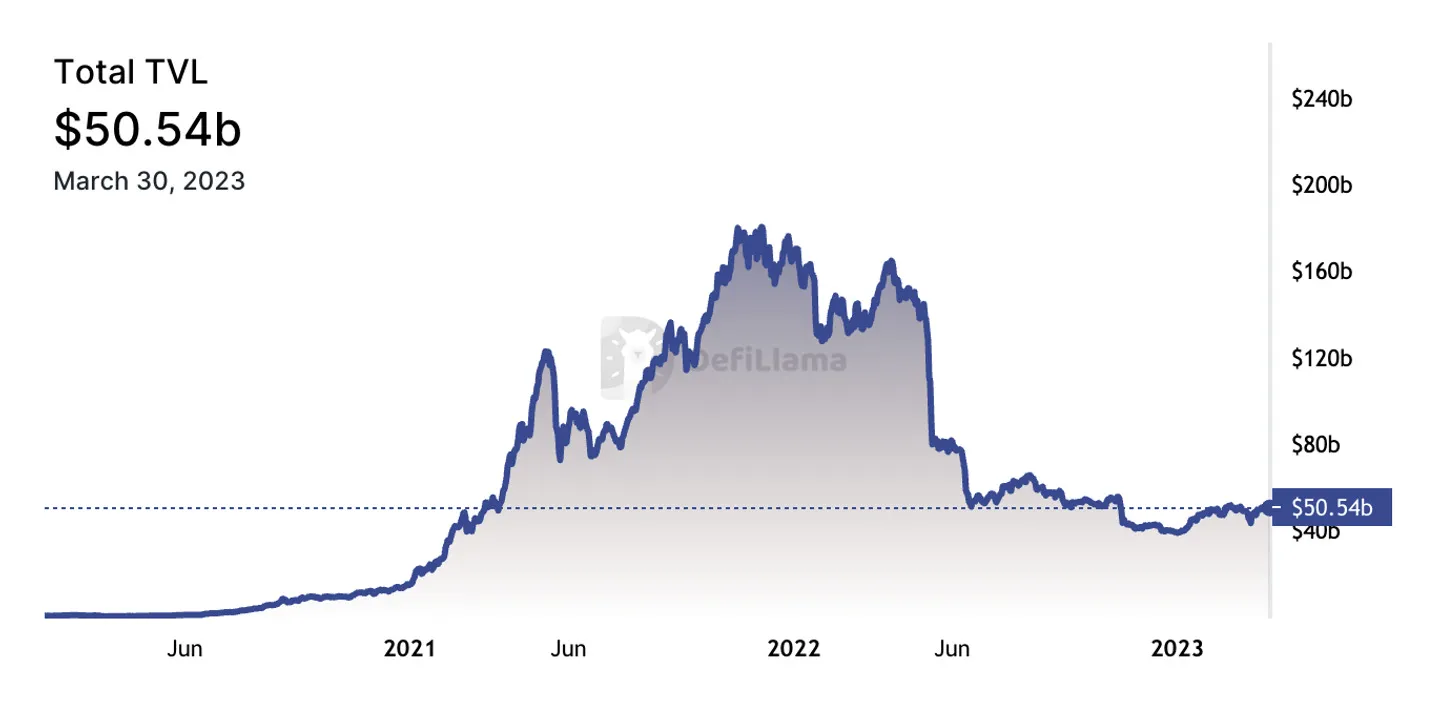
However, despite the significant drop in TVL, daily trading has not been significantly affected. If each chains transaction count reflected its daily active users, then a clear pattern would emerge, with Solana being an outlier that outperforms all other chains (for consistency, we did not consider Solanas voting transactions). This is not only due to Solanas high throughput, but also due to the growing number of projects and developer activity in the ecosystem.
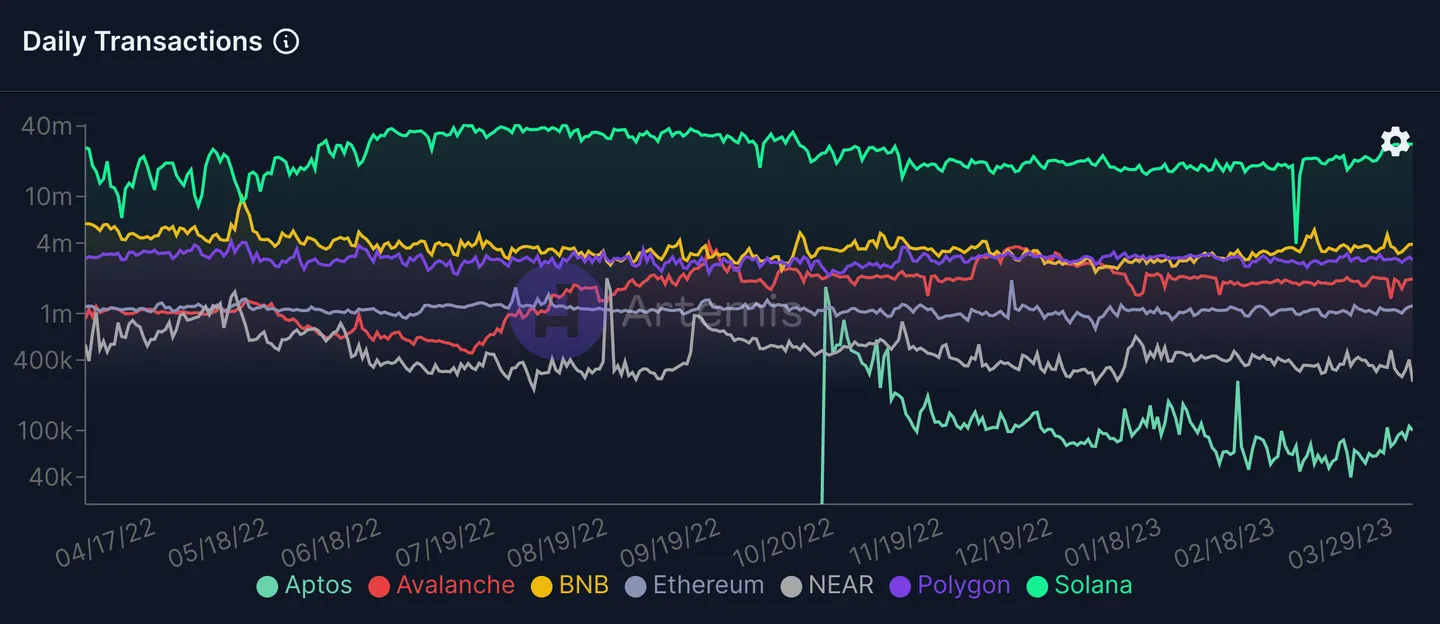
Daily transactions by month-on-month (data as of March 30, source: Artemis
Solana DeFi Overview
Despite being younger and smaller than the EVM DeFi ecosystem, Solana DeFi is thriving. Solana has the potential to build products that fundamentally cannot be built on Ethereum. We believe that the raison d’etre of Solana DeFi is not to be a low-cost version of EVM DeFi; instead, the Solana DeFi ecosystem implements a new design that brings more value to stakeholders. For example, order books like CLOB are needed to bring TradFi-like trading volumes to DeFi due to superior price discovery and liquidity provision.
The Solana ecosystem was severely affected by the collapse of FTX in November 2022. Many project teams either have funds on exchanges or are supported by FTX and Alameda. Solana DeFi was just recovering from the $100 million breach of Mango Markets last month, but liquidity evaporated after FTX went bankrupt. Because the SOL token price fell from $35 to less than $14 in a few days, TVL also fell from $1 billion to nearly $300 million.
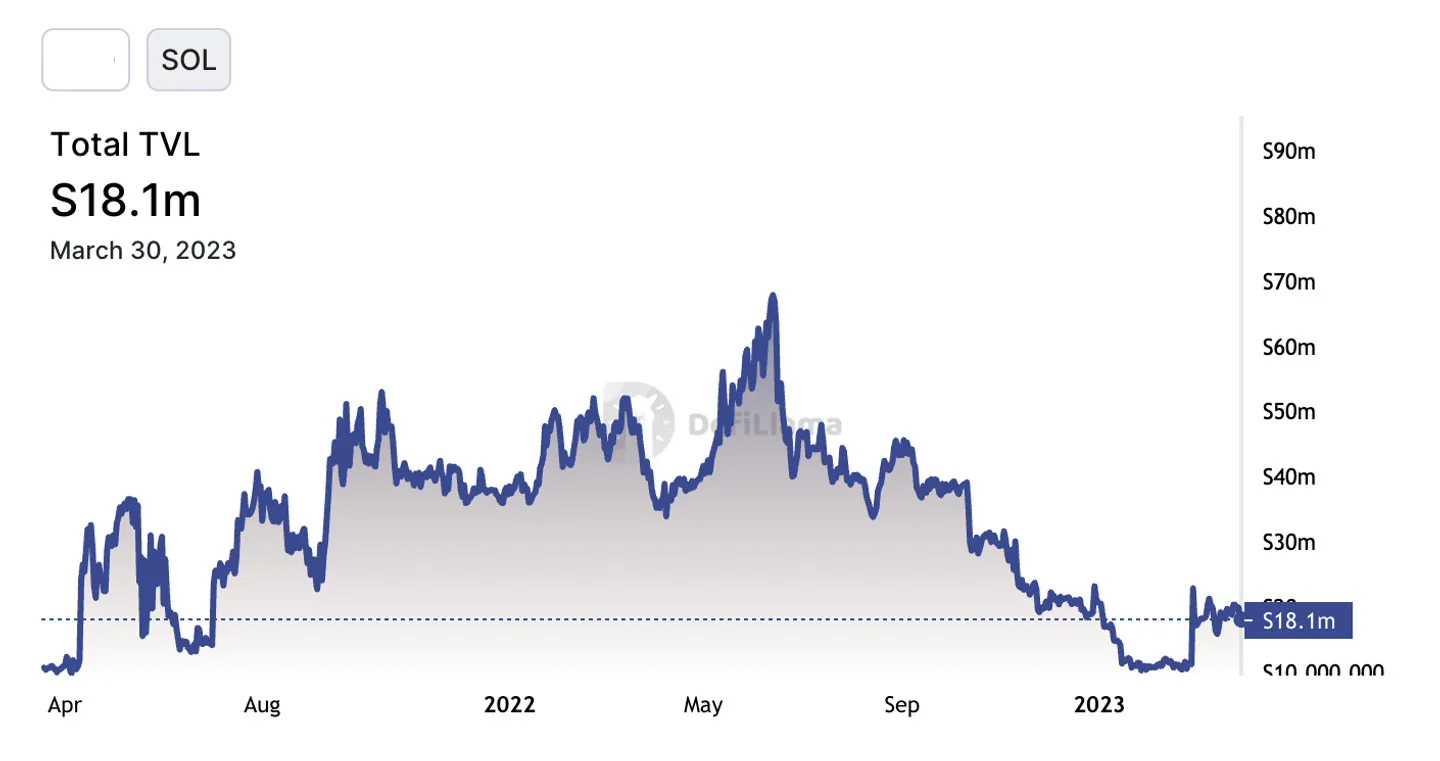
Solana TVL denominated in SOL (Source: DeFiLlama)
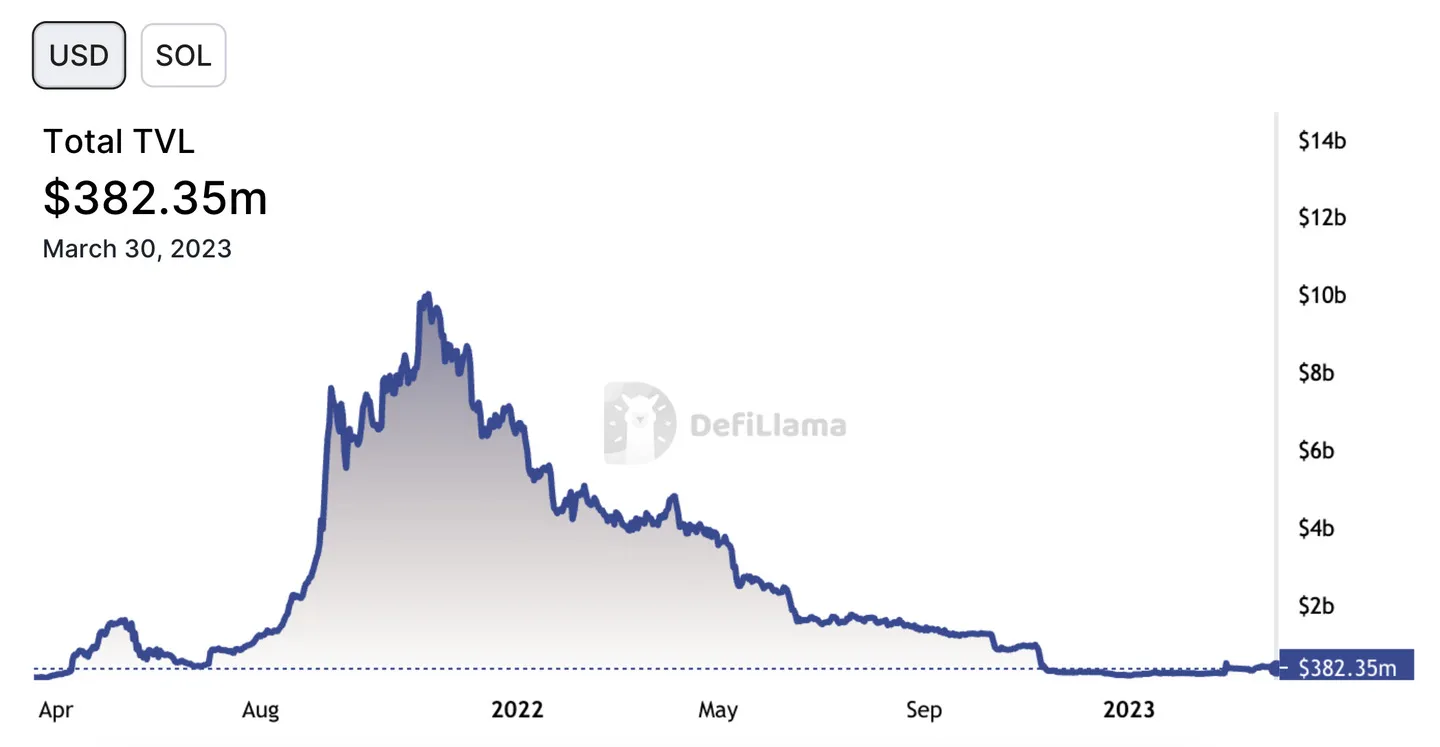
Solana TVL in USD (Source: DeFiLlama)
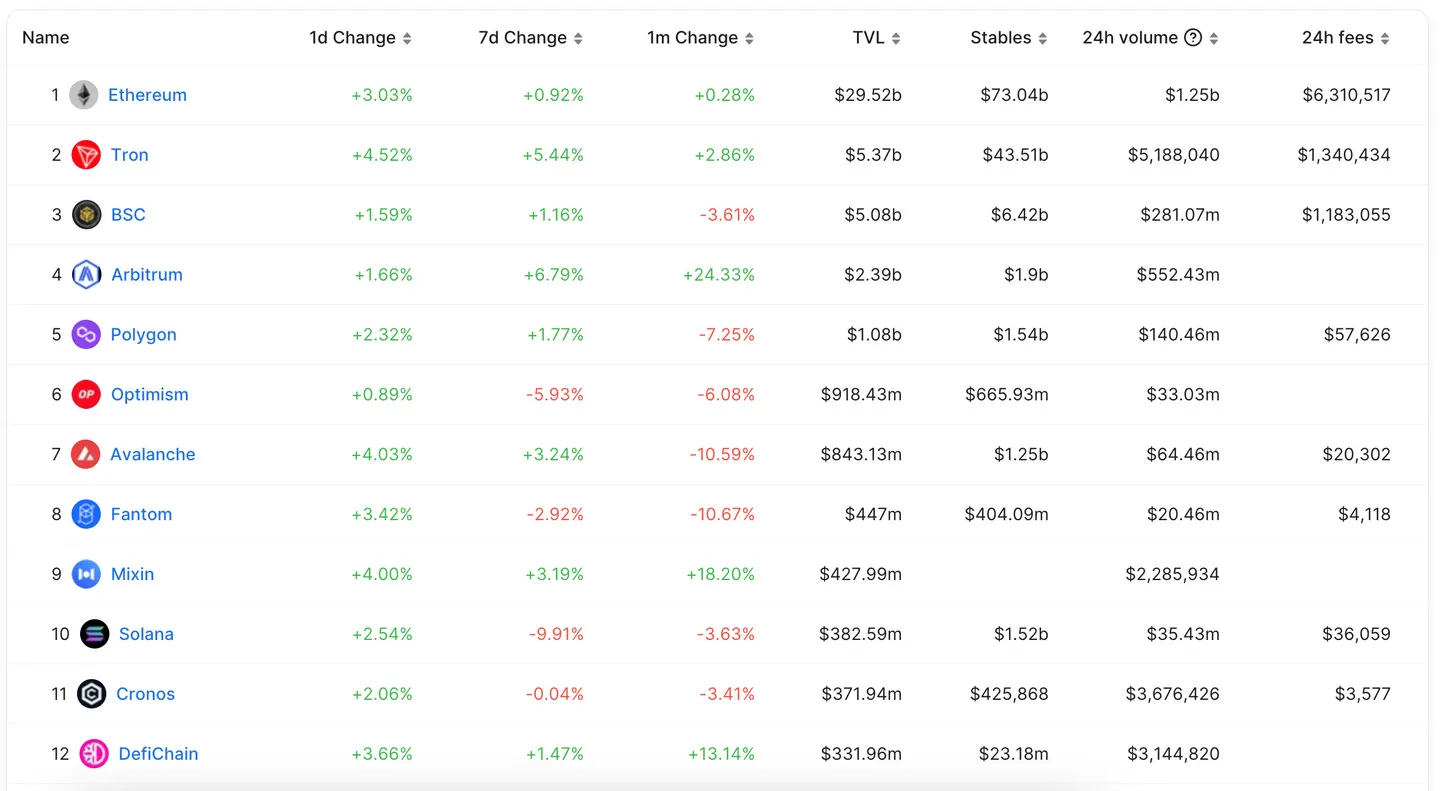
Ranking by TVL (data as of March 30, source: DeFiLlama)
Solana’s high capital efficiency
TVL can be misleading because double counting can inflate the metric. In contrast, DeFi Velocity is a metric used to compare cross-chain activity. DeFi speed is calculated by taking the ratio of 24-hour DEX trading volume to the chain’s TVL. The higher the DeFi speed, the more active the DeFi ecosystem will be.
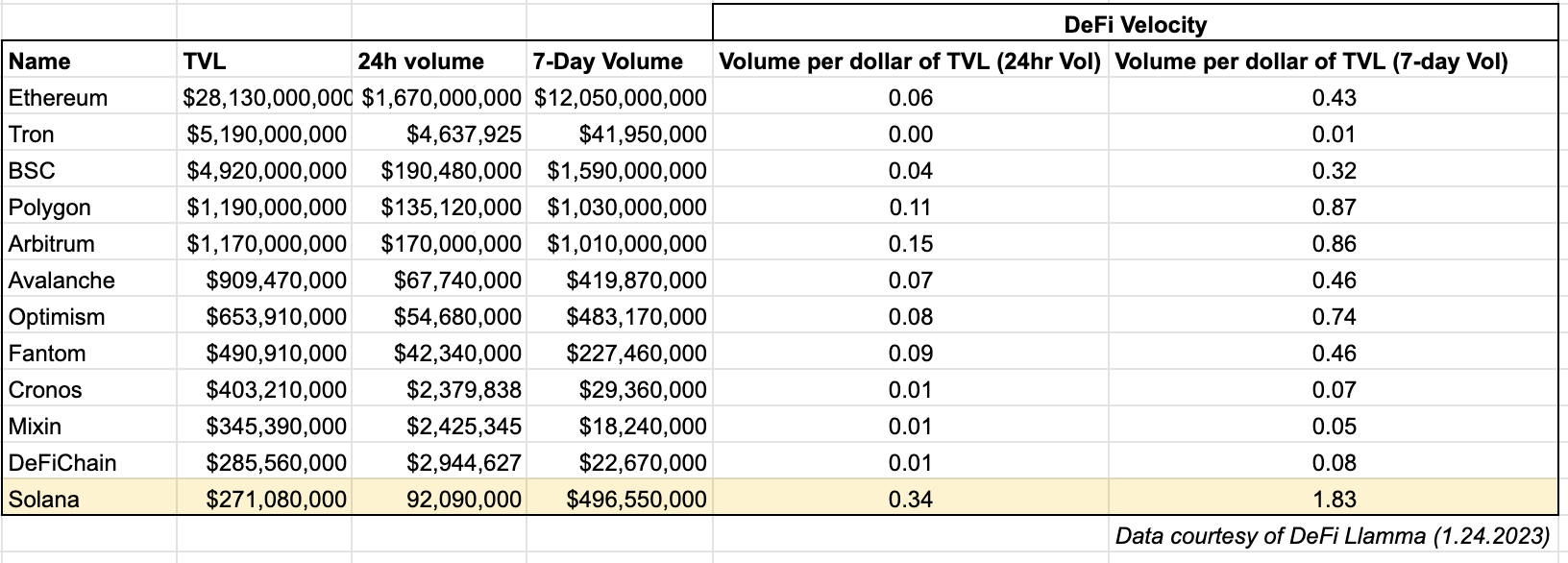
DeFi speed metrics across different ecosystems
The concept of speed is not new. In traditional finance, velocity refers to how quickly money changes hands in the economy. A high flow of money is often seen as a sign of a strong and healthy economy because it shows money is being used repeatedly to purchase goods and services. Another way to look at velocity is capital efficiency. High DeFi speeds indicate that digital assets are actively traded and capital is being put to work.
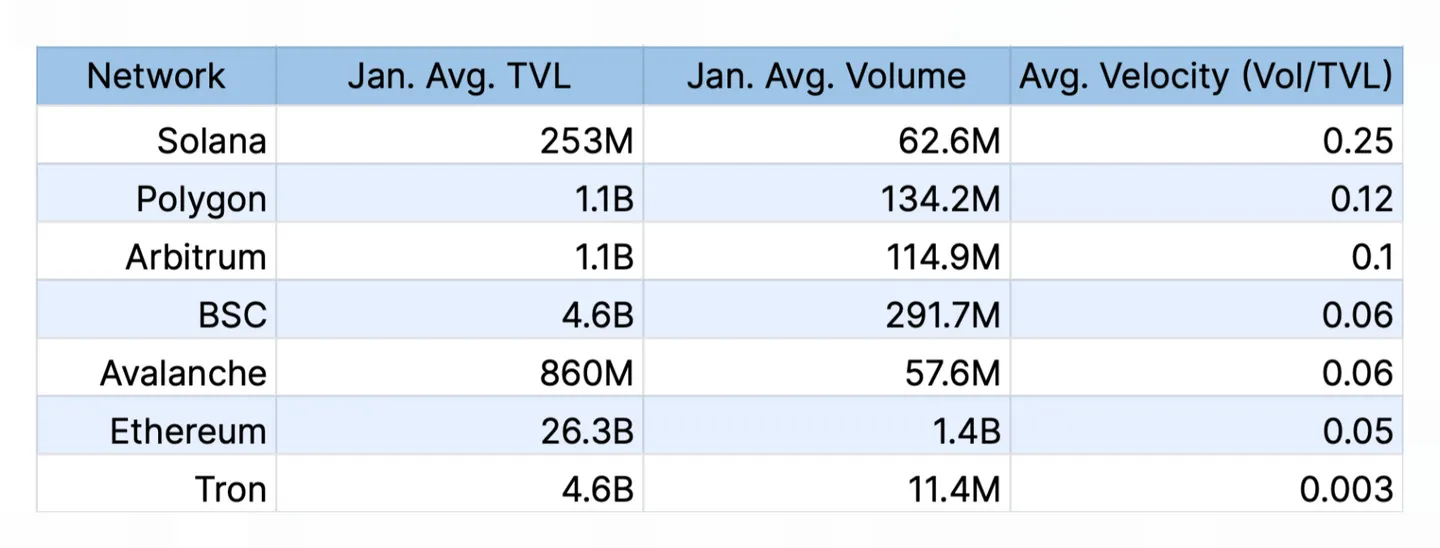
Solana has high DeFi speeds compared to other blockchain networks. In January 2022, Solana’s DeFi speed was 0.25 Vol/TVL, at least twice as fast as other networks. This shows that Solana’s DeFi ecosystem is more active (albeit smaller) than its competitors. Even if we exclude the outlier Bonk effect between January 3rd and 8th, when Solana recorded the highest DEX trading volume for the month (over $150 million in trading volume, two-thirds of TVL), the network still managed a 0.21 Speed leadership chart.
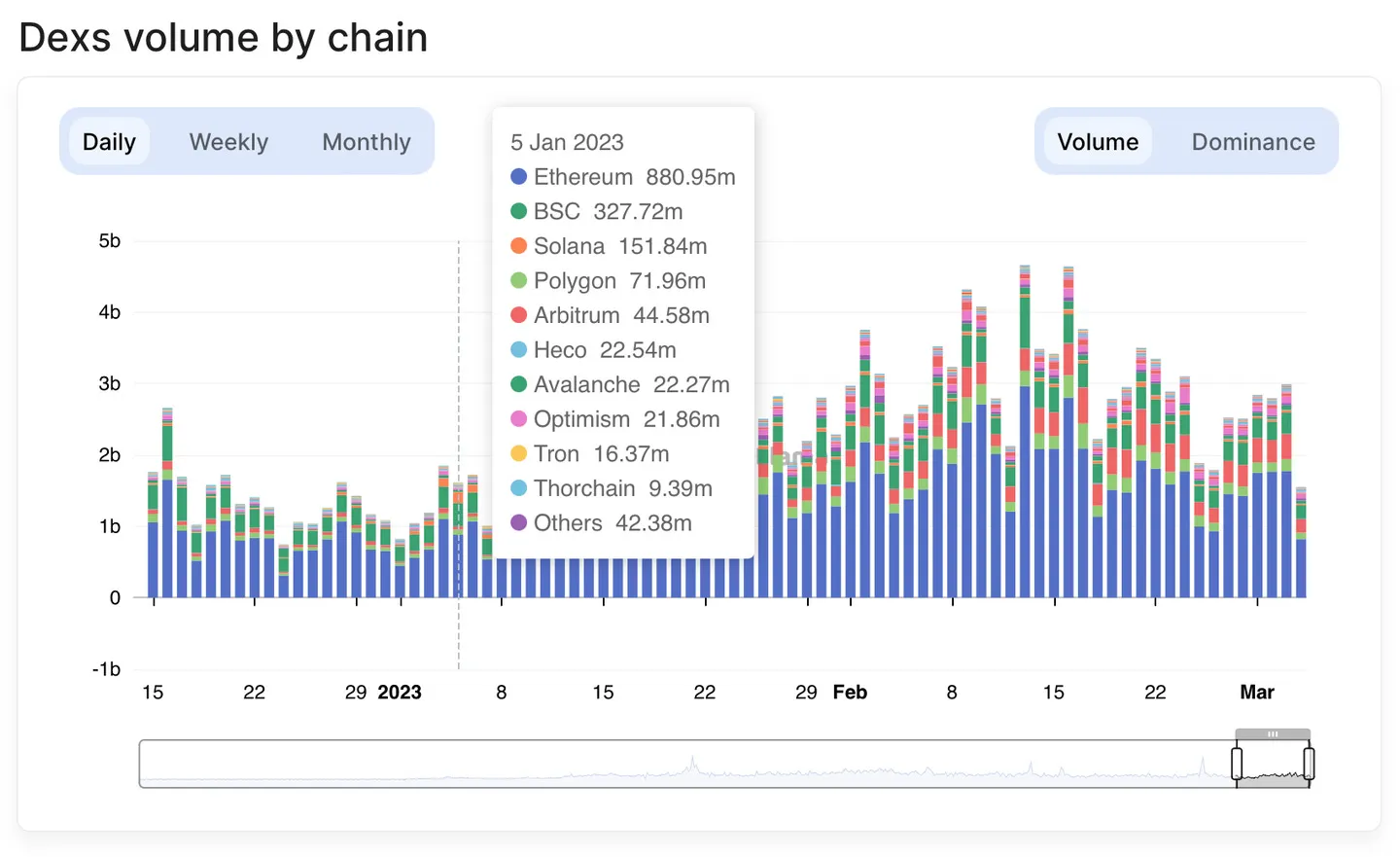
Networks such as BNB Smart Chain, Avalanche, and Ethereum have weaker trading ecosystems than Solana, although the TVL is much higher. This suggests that the DeFi speed metric more accurately depicts the blockchain’s economic activity than TVL alone.
Tron’s DeFi velocity is 0.003, indicating there is a lot of money parked. This suggests that DeFi speed provides a more accurate measure (or at least another way) of economic activity on the blockchain.
This from Kamino FinancePostDeFi speed explained in more detail.
Let’s now delve into each DeFi category or topic and analyze their strengths, limitations, and opportunities that exist.
The path forward for DEX, CLOB and AMM
The collapse of FTX caused a loss of trust among users and is a stark reminder of the importance of a transparent and auditable public ledger. Unlike centralized exchanges, DeFi platforms are a more transparent option for users because they maintain custody of funds. In addition to new decentralized exchange (DEX) competitors, we are also seeing semi-custodial exchanges and wallets leveraging multi-party computation (MPC) and threshold signatures to prove the security of users’ funds while providing them with a familiar CEX user experience .
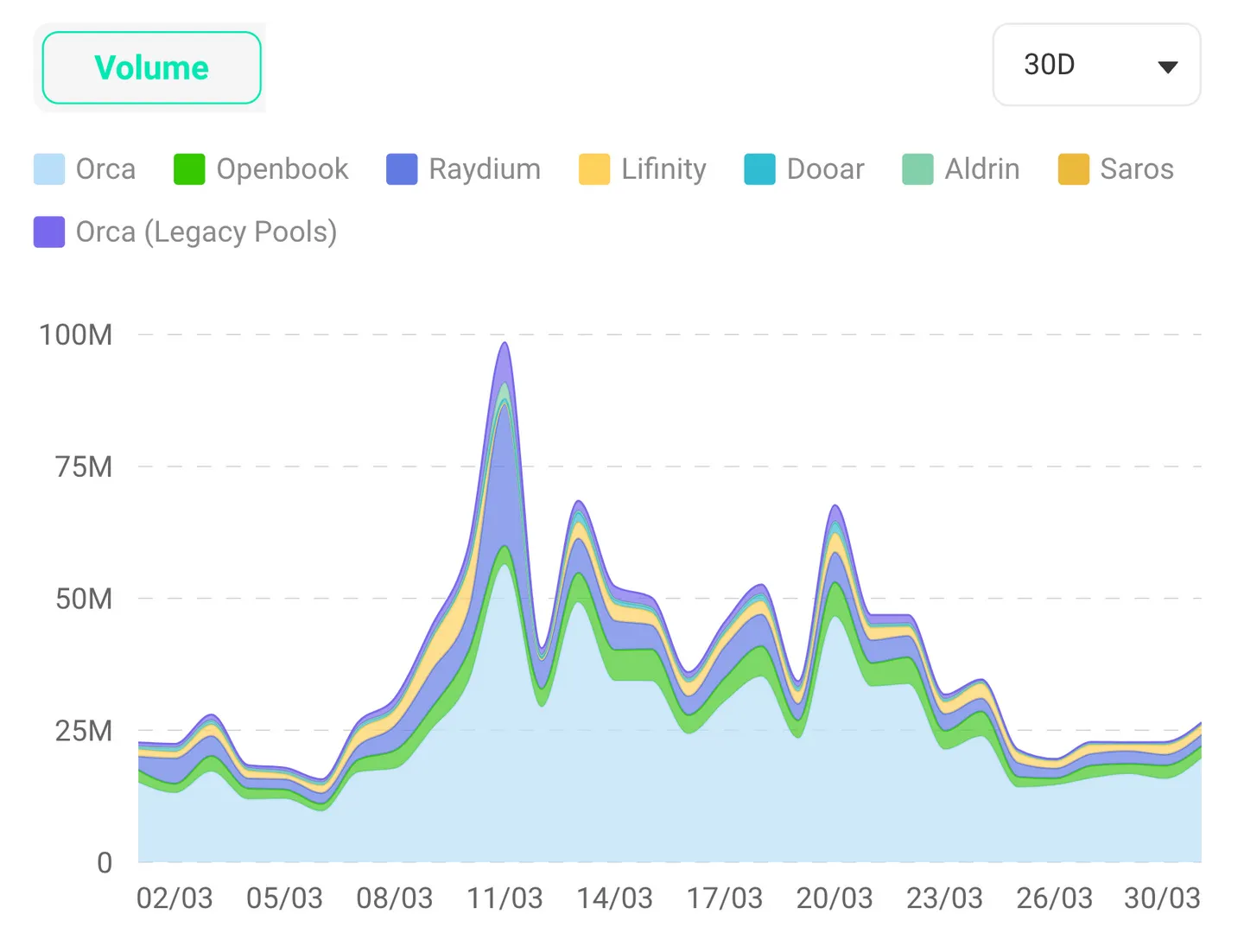
Orca has become Solanas main DEX, accounting for more than 74% of the total trading volume, followed by OpenBook, Raydium, Lifinity and Aldrin. However, we still see innovation from projects like Root Protocol, which builds a hybrid DEX that combines the efficiency of an AMM with the flexibility of an order book.
More crypto-native users may switch from CEX to self-custodial trading on DEX. However, a big barrier to widespread adoption is the stark contrast in user experience. Although some EVM DEXs have high trading volumes, many DEXs attract trading volume through additional token incentives. If the user experience gap is not significantly narrowed, it will be difficult for DEX to surpass CEX in terms of quantity and liquidity.
CLOB status
First, a brief history of Web3. In the early days of FTX, SBF talked to every major L1 in the market, looking for a blockchain that could support his on-chain CLOB vision. After stress-testing the then-unknown Solana in 2020 and having a 3 a.m. phone call with Anatoly, Project Serum was born.
Serum is one of the first on-chain CLOBs, driving the growth of Solana DeFi. Traders can experience a decentralized version of the order book they are familiar with in traditional finance. After FTX collapsed, the DeFi community forked the Serum code into a public product and named it OpenBook.
There are now two live CLOBs on Solana: the widely adoptedOpenBook, and the Ellipsis Labs alternative Phoenix. For a detailed analysis of OpenBook, see thisSuperteams post. Both projects are open source.
OpenBook uses operations-intensive and centralized processes to ensure orders are matched correctly. Transactions are batched on a regular basis. Trades can be processed immediately and reduce the possibility of front-running and other forms of market manipulation. While Phoenix’s original design would require institutional market makers to reveal their identities or be whitelisted, their v2 will enable permissionless and anonymous liquidity provision.
Design Choice: One way to design the order book is as a separate application chain, but with the trade-off of composability. This can be like dYdX v4 or Sei. This allows for customizability without compromising the speed and low cost of Solana via the Solana Virtual Machine (SVM). Running an off-chain order book like dYdX v3 or a 0x exchange could be another example of a different design approach.
Scalability: The launch of Jump Crypto’s second validator client, Firedancer, on Solana will be interesting as it may further increase Solana’s performance by 10x or more. Firedancer has over 1 million TPS in the test environment, opening up new possibilities for on-chain HFT and derivatives trading.
New Markets: Markets can be built with new applications and asset classes, from running licensed order books for importing and exporting commodity goods to trading collectibles like rare spirits; the opportunities are endless.
The case of on-chain foreign exchange (FX) market
Forex is a huge market, with daily trading volume exceeding $6 trillion, and many Web3 players are eyeing this opportunity. Uniswap and Circle have released a research report describing the different models and roles of “exchanges” and “tokenized cash issuers” to facilitate on-chain FX markets. The paper argued that AMMs would reduce the likelihood of flash crashes during periods of high market volatility.
But I disagree: CLOB is a better market structure than AMM for the Forex market because it has less price impact and better trade execution. The foreign exchange market is a key part of the chain that integrates global economic activity. As the most liquid market in the world, the FX market has a microstructure in the order book that AMMs simply cannot match. Ask any large market maker in this space, they would rather provide liquidity on a LOB (limit order book) than an AMM.
EVM-based chains have oracle-based synthetic foreign exchange markets, but fiat-backed stablecoins are still limited to major currencies such as the U.S. dollar, euro, and yen. However, as more native stablecoins are launched on Solana, we expect to see more complex FX trading between stablecoin pairs.
Lending: Beyond Speculation
Decentralized Decentralized lending provides users with a way to obtain funds without an intermediary. We can categorize lending activity by collateral type: cryptocurrency-backed and real-world asset (RWA)-backed.
Cryptoasset-backed mortgage lending
Solana has seen the emergence of various decentralized lending protocols that operate on a collateralized basis. The most notable are Solend, Port Finance, Francium, Tulip, Hubble Protocol (actually the only remaining player in the overcollateralized stablecoin market), Jet Protocol, marginfi, Ratio Finance, and Larix.
Bull markets build a lot of lending infrastructure, while bear markets allow us to stress test various models. A well-designed infrastructure should allow users to obtain loans quickly and easily with minimal friction, and Solana does this well. This efficiency refers to the speed and convenience of the lending process.
Despite this, leading protocols like Solend are struggling due to lack of liquidity, but they are coming up with potential solutions in their v2. Mortgages do not solve many real-world problems and are mainly used for speculative purposes such as leveraged trading. This is why the FTX fiasco has severely affected this sub-sector, as oracles are fetching FTX prices that do not match the actual price.
If we look at the EVM chain, they have strong mortgage lending projects such as AAVE with a TVL of $4.8 billion (February 2023). AAVE, for example, has been liquidating all of its loans robustly while innovating on multiple fronts such as the yield-generating GHO stablecoin, cross-chain lending, Centrifuge’s RWA program, and flash loans. Ethereums first-mover advantage and the inability of large whales to cash out to traditional financial systems are contributing factors to its TVL.
We are particularly excited about the following opportunities:
On-chain businesses: Bring more businesses on-chain and work with multi-signature providers like Squads to power loans with lower collateralization rates (100 – 150%) or even under-collateralization (collateralization rate <100%) use cases , a group of decentralized institutional underwriters act as validators of the protocol. This is like a multi-signature guardian who will approve loans to on-chain entities. The best part is that the loan details can all be on-chain and encrypted to the necessary extent.
Another huge opportunity for mortgage lending is tokenizing RWA and bringing debt on-chain. Projects like Centrifuge, Figure and the recent Apollo transaction are exploring this. By tokenizing assets such as real estate, invoices and royalties, these projects aim to create new investment opportunities and make it easier for businesses to access capital. If successful, this could lead to significant expansion of the mortgage market and bring more real-world use cases to DeFi.
Aave’s GHO stablecoin provides an ideal case study for what is possible on top of a lending protocol that can also be built on Solana.
Some exciting projects to watch on Solana in the coming months will be:
marginFi:marginfi launched and bootstrapped over $1.5 million in its first day. Margin structures are also evolving towards a prime brokerage model, where assets on margin can be used to go long on Zeta or Drift or Cypher.
Solend v2: Solend is one of the largest lending projects on Solana and has gone through several battles since its launch, from network outages to spectacular explosions. These resulted in learnings that, combined, resulted in Solend V2, an improved lending protocol. Check out their latest white paper.
RWA
Making loans based on verified on-chain holdings and tracking an entity’s balance can help reduce risk by guiding lenders’ decisions. Finding the ideal business model and regulatory framework is challenging. This follows setbacks for institutional lenders such as Celsius, BlockFi and Hodlnaut. Because of the way these traditional lenders operate, there is no transparency into borrowers and the money being lent.
RWA case: Credix Finance
Credix Financehas been growing, with more than $200 million in credit committed. Credix Finance is building a credit ecosystem designed to bridge the gap between institutional borrowers and investors by accessing liquidity and creating attractive risk-adjusted investment opportunities. Credix uses consumer loans, such as car loans and invoices, as well as invoice receivables as collateral in its loan pools. Additionally, some of these loans are underwritten by established reinsurers such as Munich Re.
RWA projects are also attracting funding from other ecosystems, as Credix Finance does, which aggregates USDC from Solana and Ethereum but builds the execution layer on Solana.
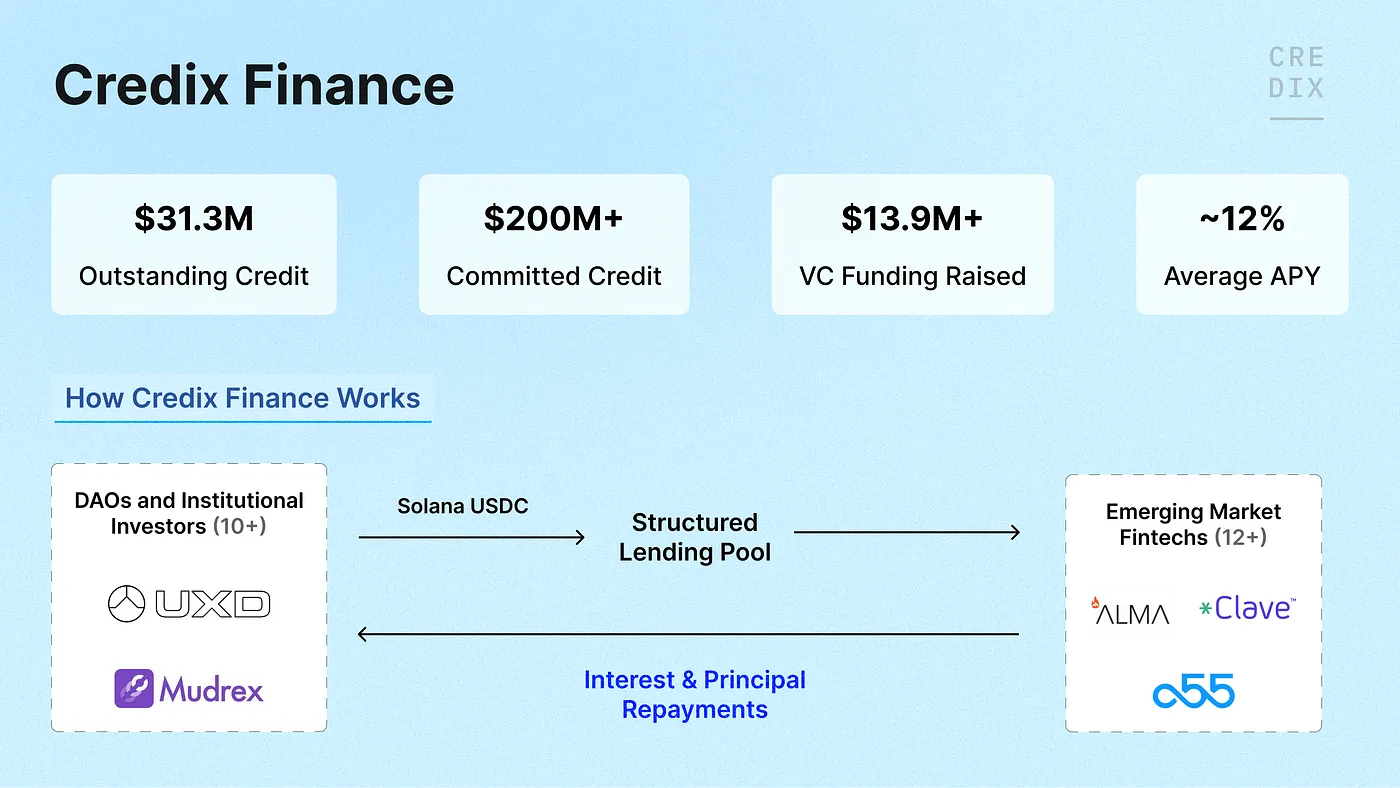
Credix is built on two main ideas:
Interesting investment opportunities exist in emerging markets that are accessible to investors because institutional borrowers in these markets often encounter geographic or capacity constraints when seeking funding. Credix solves this problem by giving these borrowers access to capital and credit that they would not otherwise have access to. As a result, emerging market fintech companies and non-bank loan originators can raise debt financing internationally with less friction and lower interest rates.
The investment options offered by DeFi will be based on tangible assets rather than the volatility of cryptocurrencies. Credix aims to provide investors with a more stable and predictable investment environment by tying DeFi investments to tangible assets, with a lower beta for cryptocurrency assets.
Read Solana Foundation’s article on Credixcase study。
Some of the exciting opportunities in the RWA space are:
Need for RWA token standards: Standards unify disparate entities on a common set of rules. For example, standards for packaging and shipping physical goods in containers have lowered shipping costs and fueled a surge in global trade. Likewise, establishing standards for risk-weighted assets on how assets are originated, classified, packaged and distributed is critical to increasing market efficiency and better price discovery.
Strong identity protocols: Decentralized IDs and verifiable credentials that can be used across protocols are an important part of a seamless UX. Although several on-chain implementations have been built (mainly around DAOs and governance), these tools have not been successful in attracting users. Therefore, the opportunity to address user anonymity and loan accountability is huge. Adoption of these projects can be accelerated by combining these identity technologies into a universal multi-factor authentication system, such as Gitcoin Passport or cryptographically owned soul-bound NFTs.
Non-standard derivatives
During the bull market, the TVL of Solana’s DeFi Options Library (DOC) surged by more than $500 million and continued until the bear market began. Unlike the forced pricing of AMMs, Solana-based derivatives platforms such as Zeta provide flexible liquidity and fair value pricing by leveraging Serum. However, DOVs such as Ribbon, Katana (not actively structuring), and Friktion (sunset) are adding some saturation to the structured products market in 2022. While these DOVs initially attracted liquidity providers with high advertised yields and low perceived risk, over time their weaknesses became increasingly apparent.
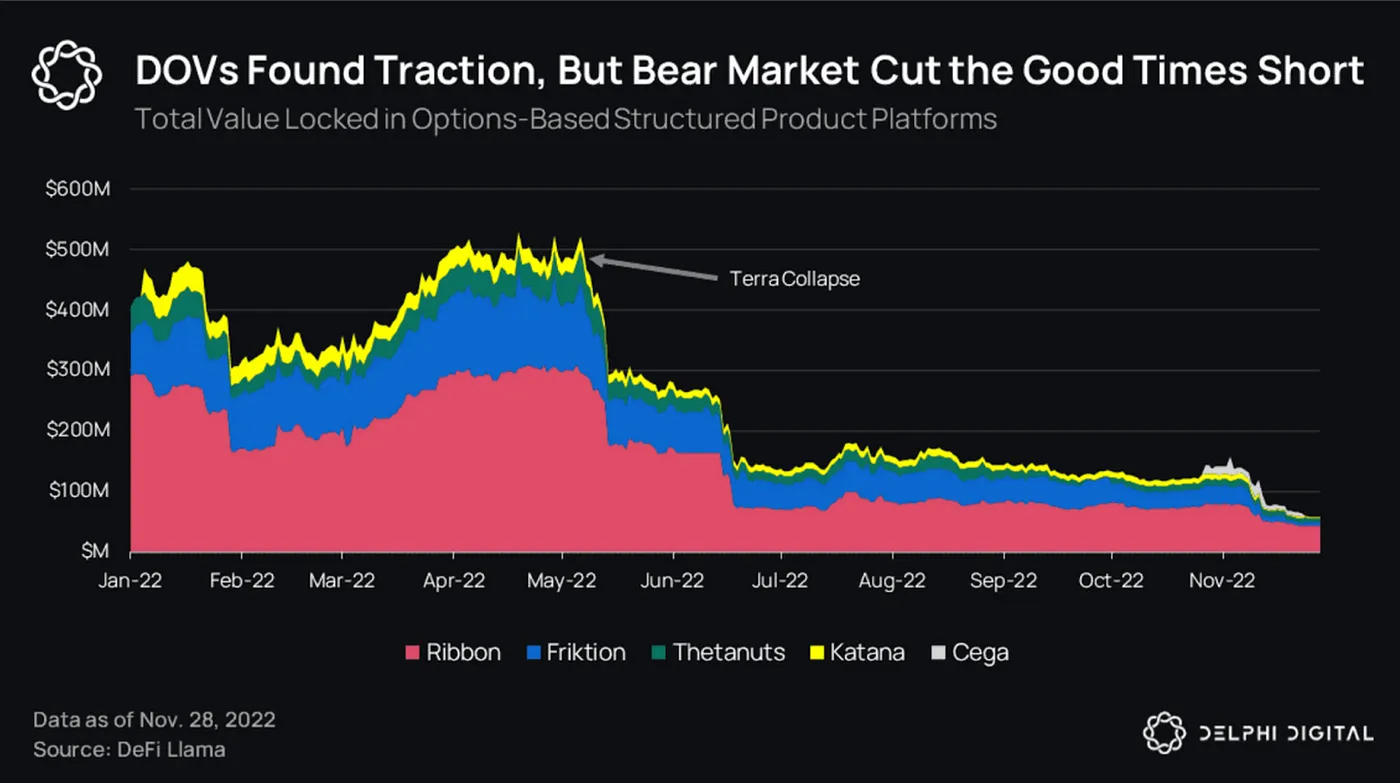
Before the FTX collapse, the DeFi options market was relatively strong. Ribbon introduces a systematic option sales vault. The model is simple: Market makers are incentivized to provide users with the necessary liquidity and earn handsome profits from management or performance fees. To hedge their positions and earn the spread, Makers are encouraged to buy call options from users on Ribbon and sell them on centralized derivatives exchanges such as Deribit.
Following FTX, many market makers adopted risk-off strategies and withdrew liquidity from the ecosystem. Rebuilding liquidity and confidence in the Solana ecosystem and options markets is a necessary step before complex structured options products can be made available at scale. The market for structured products remains well below expectations and there is a need for products with better risk-reward structures to cater to retail investors.
While options-based derivatives are battling the shutdown of protocols like Friktion, the infrastructure for the next wave of derivatives is being built on Solana as we speak; one of the innovative use cases for derivatives isFusionof airdrop options. Unlike traditional protocol token airdrops, option airdrops provide the community with greater flexibility in their contributions and protect the tokens from instant dumpers.
Here is an overview of some of the protocols being actively built:
Drift Protocol: It is a decentralized exchange designed to minimize slippage, fees and price impact on all transactions. It aims to solve the inefficiencies of bringing centralized liquidity engines on-chain. Drift Protocol has three liquidity sources:
Constant Liquidity: This is Drift’s virtual AMM designated as a source of backing liquidity, adjusting its bid-ask spread based on the inventory held.
JIT-liquidity: This is a short-term Dutch auction in which market makers compete at or above the auction price.
The Decentralized Limit Order Book (DLOB) is paired with Keeper Bots’ off-chain order monitor, providing traders with low slippage and deep liquidity.
Cypher: Cypher is an on-chain trading platform and margin engine based on Solana. It enables users to trade spot, futures, perpetual contracts and options markets from either isolated or fully margined trading accounts. It also offers a mobile trading experience optimized for convenience and time efficiency.
Through a native lending pool, Cypher supports margin trading, allowing users to initiate any derivative with a specified yield function.
It has two types of clearinghouses, public and private, that share the same liquidity and order books. A public clearinghouse is a universal, permissionless margin layer that anyone can trade on. In contrast, private clearing houses are reserved for institutional partners, resulting in lower margin requirements and thus greater capital efficiency.
Hxro allows users to trade futures, options and paper contracts on Solana. It uses its protocol to create a decentralized exchange for these financial contracts.
As of April 3, lifetime network trading volume was $232.83 M, with a 30-day average daily trading volume of $3M (including derivatives and parimutuel trading volumes)
With several community initiatives such as OpenHxro and partnerships such as Convergence RFQ and Degen Ape underway, we may see a more integrated ecosystem.
Vyper Protocolis another platform (currently in public beta and unaudited) that allows users to create, trade and settle on-chain derivatives in a permissionless and decentralized manner.
It supports trading any asset or data feed supported by oracles such as Pyth and Switchboard.
Users can build customized derivatives based on their specific needs or choose from a variety of pre-existing options.
Ribbon Finance, PsyFinance, Mango Markets, Cega, Zeta Markets, Dual Financeare a number of other protocols operating in the derivatives and structured products space. Recently, Mango Markets also launched the V4, which will be an interesting watch. Another project, Devol Network (currently in beta and due to launch mainnet in June), will allow on-chain options trading and provide fully collateralized and deep liquidity in all exercises.
The case for building a powerful perpetual contract exchange on Solana
Solana needed a reliable perpetual exchange that could provide a CEX-like experience to attract active traders to the ecosystem. One potential solution is to build a derivatives trading platform on Solana, offering products such as perpetual contracts, options and synthetic assets. The platform should offer a top-notch user experience, high leverage, and competitive fees to attract traders. A hybrid liquidity model could be explored that combines AMM with order books and cross-margining. Other key features include a mobile-friendly interface and advanced API for traders and liquidity providers.
To solve this problem, Solana Labs offers a novel sustainable marketplaceReference implementation。
To differentiate itself from other platforms, it can use Wormhole on Solana to provide cross-chain derivatives and leverage CLOB to obtain liquidity and funds from other chains. The development of Solanas derivatives market can draw inspiration from other chains such as GMX, dYdX and Gains Network.
Liquidity Staking
Liquidity staking is a capital-efficient option that utilizes pledged assets as collateral, providing greater participation and capital flows across the market than traditional financial systems.
Lido launched in December 2020 to make it easy for anyone to earn Ethereum staking income without maintaining a validator node. For Ethereum users using Lido, the choice between DeFi earnings and staking earnings is eliminated. By staking Lido and using the stETH they earned in DeFi, they now have access to both revenue streams. Currently, Lido is multi-chain, supports many chains including Solana, and ranks high on the TVL rankings of other liquidity staking protocols. The liquidity staking boom on Solana may start again as Jito Labs reallocates MEV through its validator client. Maximum Extractable Value (MEV) refers to on-chain activities that generate economic gains by exploiting market inefficiencies. The jitoSOL staking pool enables distributed value capture among many validators by additionally rewarding individuals who operate jitoSOL clients. On the other hand, over time this could lead to situations where there is a risk of centralization.
As of March 30, JitoSOL offers a staking APY of approximately 7.29%, which is higher than other leading staking pools such as Marinade (6.84%) and Lido (6.7%) on Solana. It will be interesting to see how the market reacts in the coming months and whether this will lead to a migration to JitoSOL. It’s important to note that each provider calculates APY differently. For example, Marinade shows APY based on the last 14 days, while Lido shows the highest APY for the last 14, 30, or 90 days or since launch. On the other hand, JitoSOL calculates its APY based on a theoretical block time of 400 milliseconds, which may not reflect a perfect real-world scenario. Some other players staking liquidity on Solana include the Quarry protocol, which used to be TVL’s #1 Solana protocol in early ’22. Still, once the rewards start drying up, it starts to lose its craze. Their Twitter and community are currently inactive.
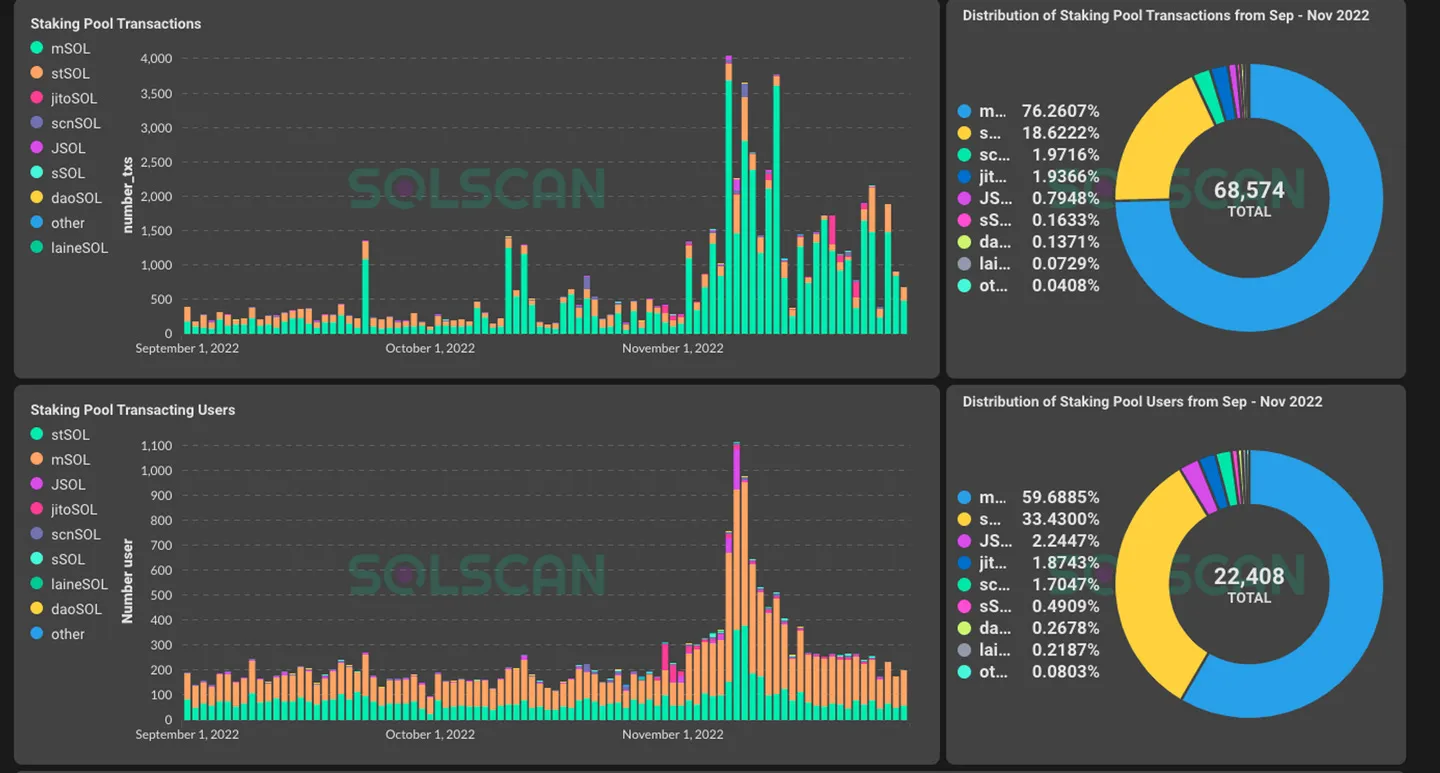
Synthetic assets and prediction markets
The easiest way to gain leveraged exposure to synthetic assets using oracles is through GMX and Gains Network. In September and October, the majority of Gains Networks trading volume consisted of FX trading. With the GMX user base significantly expanding and the upcoming launch of synthetic assets, FX trading volumes for EVM-based chains are likely to surge in 2023. Robust synthesis protocols utilizing oracles such as Switchboard and Pyth are inevitable.
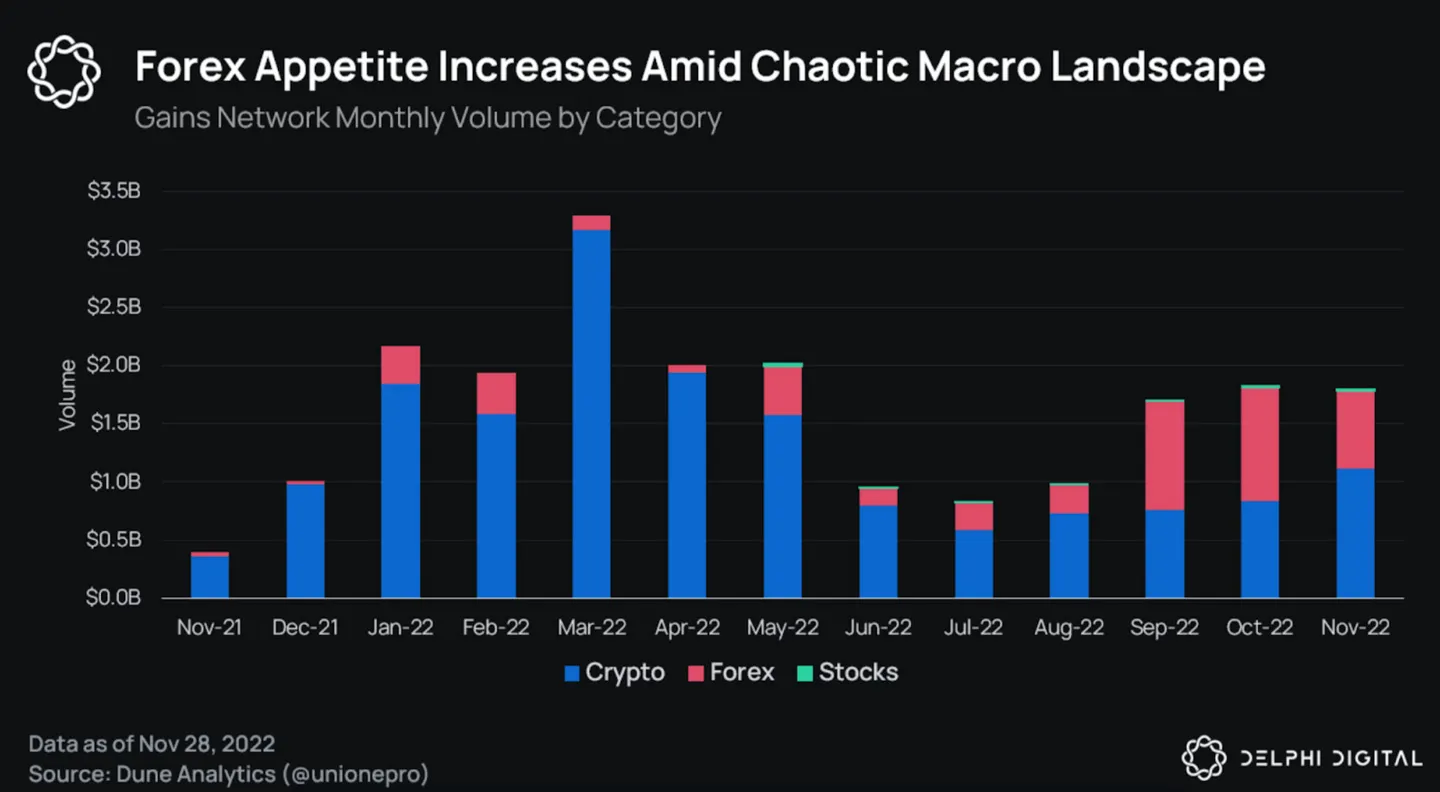
Prediction markets or betting platforms provide users with the opportunity to bet on the outcome of future events. Solana is a high-throughput blockchain that provides prediction markets with a fast and scalable infrastructure to process many transactions. Aver exchange is a peer-to-peer betting and prediction platform on Solana that eliminates the traditional concept of a house in sportsbook betting. Hedgehog is another prediction market on Solana that generates passive income for liquidity providers. In addition, Monaco Protocol also provides open source infrastructure for prediction markets on the Solana network. On the Vyper protocol, people can trade event/prediction markets built in the form of digital options.
Despite Solanas strengths, some weaknesses may limit its growth in the prediction market space. One of the weaknesses is a lack of user adoption; Solana is a relatively new blockchain platform and its prediction markets may not have as much user adoption and sufficient liquidity as Ethereum. Solana currently has limited prediction market options available compared to other networks. For users unfamiliar with the concept of prediction markets, the process of understanding and participating in these markets can be complex and intimidating. This may prevent potential users from participating in the market, limiting its overall adoption and potential impact. However, these markets have the potential to attract non-crypto-native users who can learn about tokens through gaming and then potentially participate in the DeFi ecosystem.
One of the main threats to Solana-based prediction markets is competition from other platforms, such as Polymarket on Polygon. Due to the size of their respective ecosystems, these platforms already have large user bases and more prediction market options. Another threat is regulatory challenges, as the prediction markets industry remains largely unregulated and adding layers of encryption may create challenges in the future as governments begin to regulate.
Improve the DeFi experience with UX aggregators
As the focus of the user interface, the liquidity aggregator sits on top of the liquidity aggregation layer and owns the consumers. Therefore, they are fully capable of taking over the primarily user-facing layer of DeFi. Although users own their own information through on-chain addresses and the conversion costs are low, it is not easy to make a profit in the DeFi field. Wallet-native swaps currently require ~85 basis points, while centralized exchange fees are much lower. UX aggregators should develop creative monetization strategies that do not compromise usability.
UX aggregators offer considerable advantages to novice crypto users, even if they are primarily aimed at crypto-native users. UX aggregators should provide a level of freedom while still providing an efficient user experience by limiting access to security protocols and raising alerts on high-risk tokens.
There are currently hundreds of liquid DEXs available for trading. Here, liquidity aggregators such as Jupiter on Solana and 1inch and Paraswap on other chains obtain quotes from various DEXs to find the best execution price for users. This saves users the hassle of having to visit various DEXs to find the best price or stick with a single DEX. As the DeFi ecosystem develops, liquidity aggregation may surpass DEX. It will adapt to different protocols supporting these operations, and aggregators for other DeFi products will inevitably emerge.
Jupiteris one of the most innovative liquidity aggregators on Solana (launched in November 2021) and has quickly become the dominant liquidity aggregator on Solana, with over $27 billion in trading volume and half a million users . Jupiters platform allows users to find the best prices and execute trades on multiple DEXs on the Solana network. While many major chains have DEX aggregators, few offer features such as limit orders.
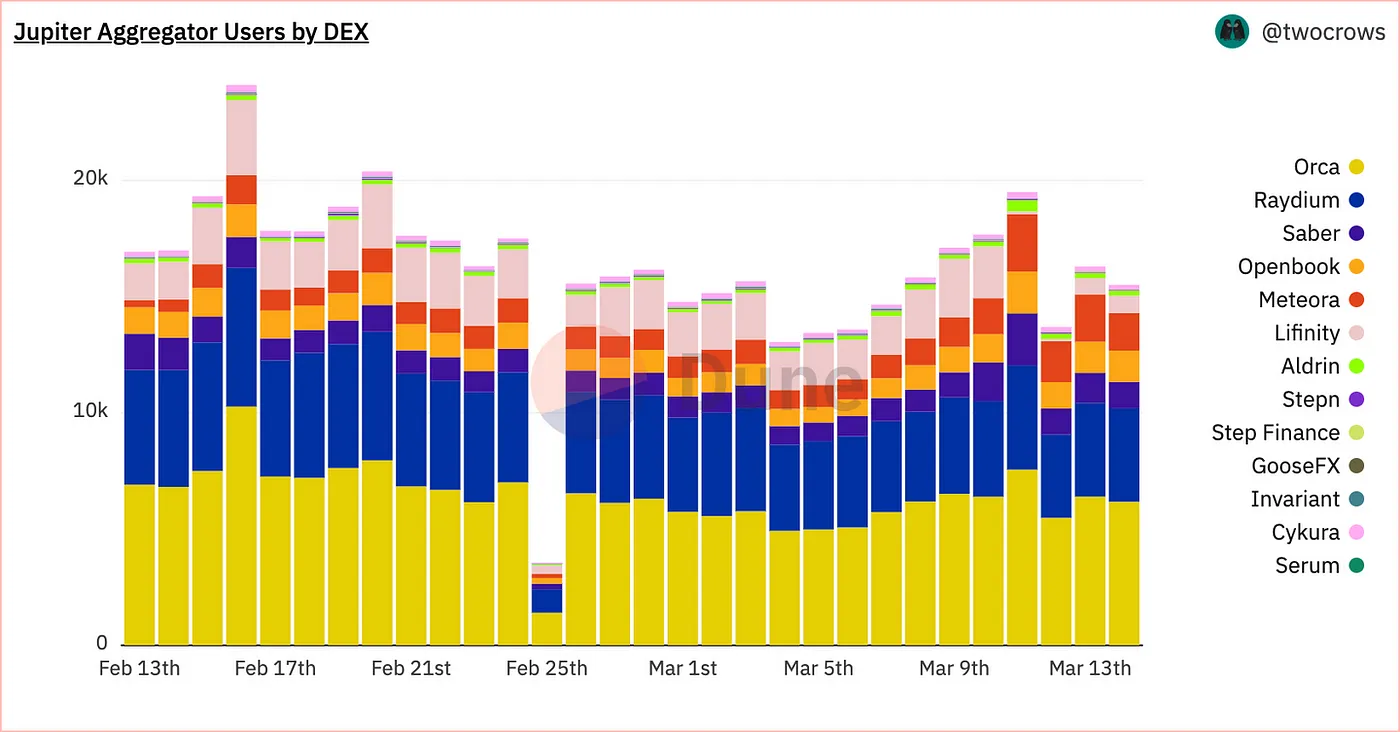
Jupiter aggregator user of DEX (Source: Dune @twocrows)
Jupiter’s transaction volume continues to be high, making it the most widely used project on Solana. In fact, Jupiter accounts for 41% of Solana’s daily non-voting trading volume. A noteworthy aspect of Jupiter’s recent success is its participation in the $BONK craze, which drove a significant amount of trading activity on the platform.
Jupiter’s success is a testament to the growing popularity of DeFi applications and the role of liquidity aggregators in facilitating trading on multiple DEXs. As more users enter the DeFi space and seek the best prices and execution, liquidity aggregators like Jupiter are likely to continue to play an important role in the DeFi ecosystem.
Some of the exciting opportunities for builders in the aggregator space are:
Build a complete DeFi UX aggregator where users can access multiple opportunities such as swaps, yield opportunities, lending rates, perpetual futures execution, cheapest/most expensive option premiums, etc. This could be similar to Step Finance, but with a friendlier user experience and a mobile-first approach, like Solanas Super Backpack app.
Deposit and withdrawal aggregator like Jupiter: It will help centralize liquidity, help users find the best route with lowest fees and unified KYC, to abstract the onboarding process of each platform, and have a better fraud detection engine , significantly improving the user experience of consumer applications. Additionally, attract more non-custodial entry/exit solutions and partner with local fintech companies to support cardless local payment methods to provide users with comprehensive choice.
Portfolio Management and Analysis
Symmetry, Step Finance, Sonar WatchAll are portfolio management and analysis tools for the Solana ecosystem. These platforms help users track the real-time performance and value of their positions on Solana, including farming, staking, and other yield strategies. One difference with Symmetry is that it allows anyone to create or purchase indexes. Sonar Watch also features sophisticated tools such as DEX Manager and IL Calculator.
However, Solana-based portfolio management applications have limited functionality compared to more comprehensive multi-chain platforms like Zapper; it may become unavailable for users who want a more comprehensive portfolio management and analytics solution. So attractive. Competition is also fierce as there are many established multi-chain platforms such as DeFiYield, CoinStats and Starlight. This may result in limited adoption of these platforms as switching costs for these applications are not high.
In addition, there are some factors that will prevent mass consumers from adopting DeFi, including but not limited to:
Lack of localization: Every DeFi product has the same story to sell to users, highlighting APY, low fees, and rewards. However, these products can be challenging for non-English speakers or those with local banking or cryptocurrency restrictions. This is a problem because these users are the ones who benefit the most from DeFi.
Onboarding new users is a clunky process: fiat deposits and withdrawals are not yet widely addressed, and self-custody requires more education.
The case for mobile-friendly dashboard apps
There are shortcomings in sticky consumer apps, especially mobile apps. We need products so good that people learn to take care of themselves to use them. The projects that have received attention are mostly speculation-based products that have not yet focused on providing more practical use cases such as loans, insurance, and other financial services. Instead, they are designed to cater to traders and investors looking to profit from trading and investing in different DeFi tokens.
While this is true for all crypto apps, having a mobile app is especially important for portfolio management projects. For most users, opening their computer just to check their portfolio involves too much work and unnecessary friction.
As the DeFi market continues to grow, the portfolio management and analytics platform on Solana can play an important role in helping users navigate and make the most of the ecosystem by providing rich data insights and analysis to help users make smarter investment decisions. effect.
Having a mobile app at your fingertips that instantly displays all the information about your portfolio is a game changer. With the launch of Saga by Solana, projects have a great opportunity to build it for a Saga dApp store.
Insurance
As more users enter the space, users will need to manage their risks and protect their investments. This provides a broad market for insurance companies to provide coverage and protection against potential losses. The development of open risk protection models, such as the one created by Amulet, is an exciting opportunity to create a new model for the entire risk protection sector. The traditional insurance industry is built on a centralized model, which often results in high costs, slow processing times and limited coverage.
Decentralized insurance protocols can provide more affordable and efficient solutions. These agreements can eliminate intermediary and administrative costs, allowing them to provide users with more comprehensive and affordable coverage options.
NFTFi
Solana is the second largest NFT chain by transaction volume and has one of the most active NFT communities. The NFT Finance or NFT-Fi space is also heating up with the emergence of Frakt, Rain and Sharky, allowing NFT lending, while Decalls allows trading of NFT options. In the future, we will see more mixing of Solana DeFi and NFTs.
Cross-chain bridges and oracles: infrastructure connecting DeFi
Wormhole and Pyth are leading the bridging and oracle spaces respectively in Solana DeFi. However, we are seeing a lot of progress in this area.
Interoperability protocols and cross-chain bridges:
Cross-chain interoperability is a key aspect of the DeFi ecosystem. Wormhole is a messaging and interoperability protocol that connects multiple blockchain networks to provide cross-chain compatibility. For context, at its peak in March 2022, there were $25 billion in capital inflows. Wormhole has an ever-expanding ecosystem of protocols that are taking advantage of its capabilities.
Another highly anticipated cross-chain protocol is Circle’s cross-chain transfer protocol, which bridges USDC by burning and minting tokens on the source and target chains. Portal Token Bridge (Wormhole itself), Atlas, Allbridge, and Mayan Finance (public beta, unaudited) are other protocols that offer cross-chain transfers and exchanges. While these bridges offer many benefits, such as permissionless transactions and smart contract composability, they also pose some challenges, such as security.
Another solution to this kind of token bridge is a full-chain DEX, which combines CEX and a token bridge. Think of them like Uniswap, but for bridges. Just like Uniswap, anyone can add liquidity to any asset. The sender converts the token into a native bridge token instead of wrapping it, and then the receiver gets the bridge token through the DEXs native chain and converts it back to the desired token. However, the intermediate chain induces its own vulnerabilities, and additional swaps bring additional fees and slippage.
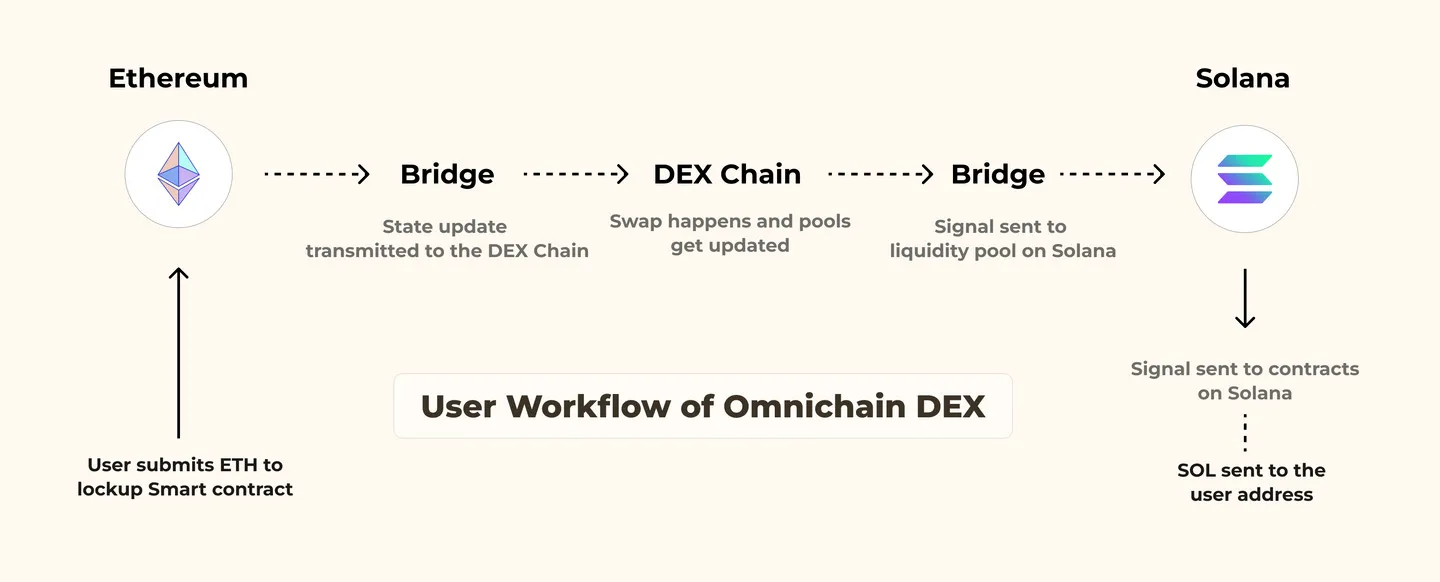
Solana relies heavily on Wormhole as the only cross-chain liquidity, and all bridges are built on Wormhole as the core messaging layer. Currently, most other bridges focus on EVM and Cosmos-based chains. For them, adding Solana requires additional development work due to different runtimes. However, we see Bridges adding support for Solana in the coming months.
Some exciting opportunities in the field of cross-chain interoperability could be:
Native asset exchange: Unwrapping wrapped assets on the target chain is a headache, with a total bridge time of 10-20 minutes (or days). In this case, native asset exchange may be the answer. In this process, when the source chain (such as Solana) destroys USDC, a USDC will be created on the target chain (such as Ethereum). Because assets such as USDC are truly interoperable between chains, Circles cross-chain transfer protocol can provide a wide range of seamless applications in payments and lending.
Cross-chain identity: As the on-chain identity market rises, interoperability between chains will be a huge opportunity, enabling developers to request user information from other networks. One of the largest identity ecosystems is ENS (Ethereum Name Service). What if developers could build a “log in with ENS” system, even on Solana or Sui, by accessing a user’s cross-chain data (xData)?
Essentially, an end user’s avatar, name, wallet address and other details can be read by applications on other chains without the user having to re-upload that information on a different blockchain. Another important opportunity in this direction is cross-chain reputation.
Good user experience and trustworthy cross-chain dApp: We need to produce a user experience comparable to a Web2 application, where you dont feel like crazy things are happening in the background. We have to ensure that nothing is lost in transit and that when the siled states of the blockchain are brought together across the bridge, everything is completely secure. Because at the end of the day, if users lose money, thats ultimately a bad user experience. Just like globalization in the 1990s gave birth to multinational corporations, with cross-chain interoperability, cross-chain applications will allow anyone to seamlessly experience the rising web3 world with 100x the user experience.
Oracle
To access off-chain data, an “oracle” is required. This is seen as a bridge to the outside world. After being launched on the devnet in April 2021, pyth was launched on the Solana mainnet in August 2021. In just over a year, it has captured over 90% of Solanas addressable market TVS (total value), 550 K+ client downloads, and a value of 5 billion.
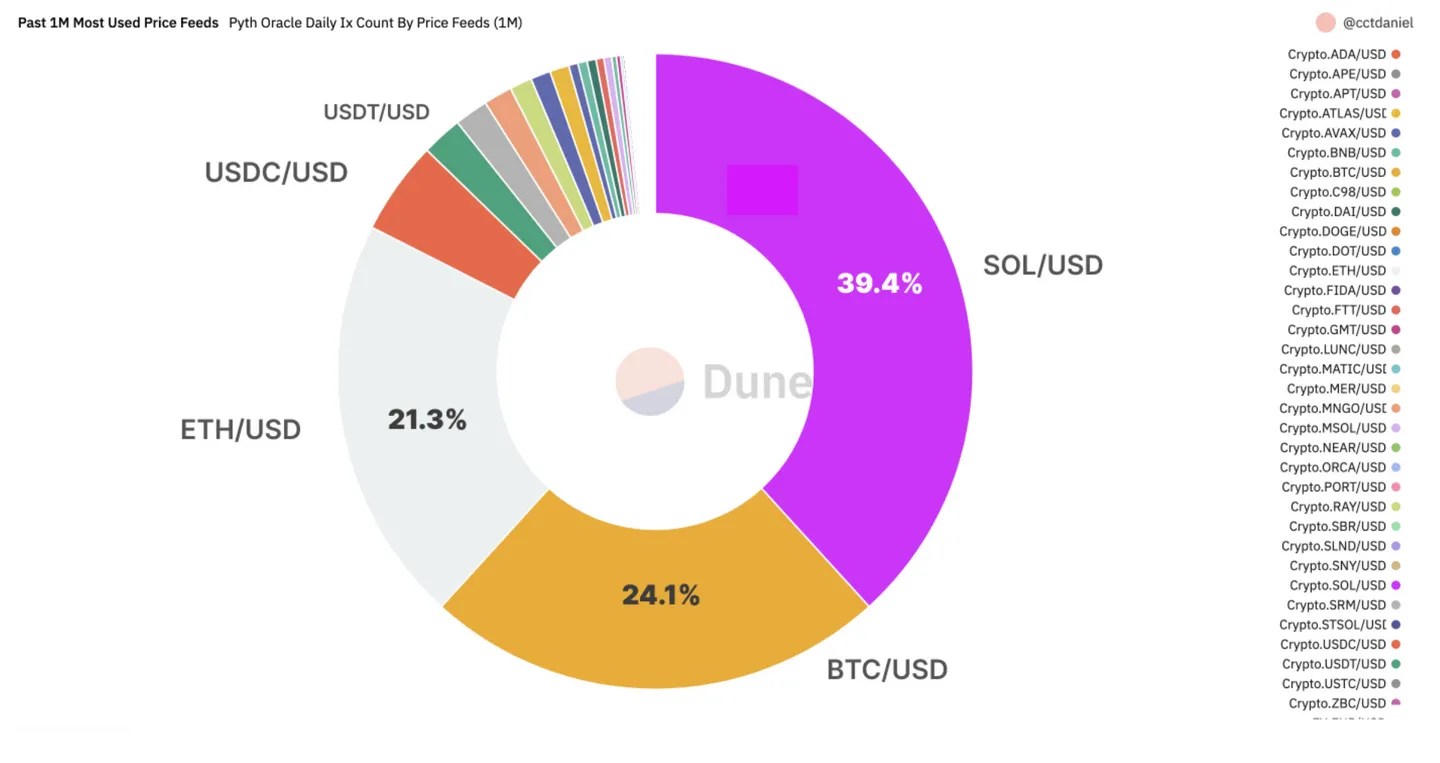
While Pyth is the dominant player in Solana (>90% market share), Switchboard is another emerging player on Solana. In the Ethereum ecosystem, there are established players like ChainLink, which pose a serious threat to oracles on Solana in the multi-chain future. In comparison, ChainLink has 1,000+ data consumers, supports 12+ blockchains, and at its peak in December 2021, the total value reached US$75 billion, and the cumulative transaction value reached US$6+ trillion. Currently, the data feed is dominated by crypto-USD pairs; however, as we bring more and more applications and financial assets on-chain, the need for reliable external data will only grow exponentially.
On-chain RWA assets: As more and more real-world assets (such as trade finance, income-based financing, carbon credits, and real estate) come on-chain, there will be a strong need for reliable data for these external assets. For example, if someone wanted real estate in New York to be traded on the chain, they would need a real estate price oracle through which they could obtain reliable and robust prices. One project in this area is Parcl. It enables users to trade global price movements of real estate assets with permanent exposure to synthetic assets through AMMs. In addition, Solana’s